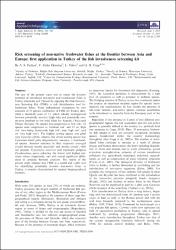| dc.contributor.author | Tarkan, Ali Serhan | |
| dc.contributor.author | Ekmekçi, Fitnat Güler | |
| dc.contributor.author | Vilizzi, Lorenzo | |
| dc.contributor.author | Copp, Gordon H. | |
| dc.date.accessioned | 2020-11-20T16:18:08Z | |
| dc.date.available | 2020-11-20T16:18:08Z | |
| dc.date.issued | 2014 | |
| dc.identifier.issn | 0175-8659 | |
| dc.identifier.issn | 1439-0426 | |
| dc.identifier.uri | https://doi.org/10.1111/jai.12389 | |
| dc.identifier.uri | https://hdl.handle.net/20.500.12809/3486 | |
| dc.description | WOS: 000333452200020 | en_US |
| dc.description.abstract | The aim of the present study was to assess the invasive potential of introduced non-native and translocated fishes in Turkey (Anatolia and Thrace) by applying the Fish Invasiveness Screening Kit (FISK), a risk identification tool for freshwater fishes. From independent evaluations by two assessors of 35 species, calibration of FISK for Turkey identified a threshold score of 23, which reliably distinguished between potentially invasive (high risk) and potentially non-invasive (medium to low risk) fishes for Anatolia (Asia) and Thrace (Europe). No species was categorized as low risk', 18 species were categorized as medium risk' and 17 as high risk' (two being moderately high risk', nine high risk', and six very high risk'). The highest scoring species was gibel carp Carassius gibelio, whereas the lowest scoring species was Caucasian dwarf goby Knipowitschia caucasica, a translocated species. Assessor certainty in their responses averaged overall between mostly uncertain' and mostly certain', with red piranha Pygocentrus nattereri and topmouth gudgeon Pseudorasbora parva achieving the lowest and highest certainty values, respectively, and with overall significant differences in certainty between assessors. The results of the present study indicate that FISK is a useful and viable tool for identifying potentially invasive non-native fishes in Turkey, a country characterized by natural biogeographical frontiers. | en_US |
| dc.description.sponsorship | NATO Science Programme 'Collaborative Linkage Grant'; British Council grant; Mugla Sitki Kocman UniversityMugla Sitki Kocman University; UK Department of Environment, Food and Rural AffairsDepartment for Environment, Food & Rural Affairs (DEFRA) | en_US |
| dc.description.sponsorship | Conceived within the framework of an international network initiated with a NATO Science Programme 'Collaborative Linkage Grant' (awarded to GHC) and further developed during a British Council grant (awarded to AST), this study benefited from support (participation by A.S. Tarkan) from Mugla Sitki Kocman University. Participation of G.H. Copp was made possible through support from the UK Department of Environment, Food and Rural Affairs. | en_US |
| dc.item-language.iso | eng | en_US |
| dc.publisher | Wiley | en_US |
| dc.item-rights | info:eu-repo/semantics/openAccess | en_US |
| dc.subject | Freshwater fishes | en_US |
| dc.title | Risk screening of non-native freshwater fishes at the frontier between Asia and Europe: first application in Turkey of the fish invasiveness screening kit | en_US |
| dc.item-type | article | en_US |
| dc.contributor.department | MÜ, Su Ürünleri Fakültesi, Su Ürünleri Temel Bilimleri Bölümü | en_US |
| dc.contributor.institutionauthor | Tarkan, Ali Serhan | |
| dc.identifier.doi | 10.1111/jai.12389 | |
| dc.identifier.volume | 30 | en_US |
| dc.identifier.issue | 2 | en_US |
| dc.identifier.startpage | 392 | en_US |
| dc.identifier.endpage | 398 | en_US |
| dc.relation.journal | Journal of Applied Ichthyology | en_US |
| dc.relation.publicationcategory | Makale - Uluslararası Hakemli Dergi - Kurum Öğretim Elemanı | en_US |


















